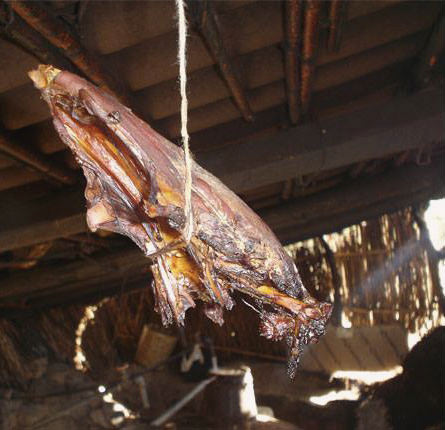We know a lot of stuff tastes like chicken. We just never assumed that would apply to liquor. But then mezcal de pechuga, the specialty mezcal made with raw chicken breast, hasn’t really been widely available. Since it’s recently seen a gain in popularity, we decided we should figure out this whole chicken/booze thing sooner rather than later. Especially if it means we get added protein in our liquor.
Before we ask what Foghorn Leghorn has to do with a classic Mexican spirit, it’d be good to remind ourselves about basic, non-poultry-flavored mezcal. If you don’t remember, mezcal is sort of similar to tequila. Except where tequila is made with one kind of agave — Blue Weber — mezcal can be made with a variety of agaves. And where agave hearts for tequila are generally steamed prior to distillation, agave hearts intended for mezcal are roasted, giving the finished product a subtle but unmistakable smokiness on top of peppery, green, and fruit notes. Hard to improve on classic mezcal, though pechuga may do just that.
Now, on to the question we never thought we’d be asking: how did the chicken get involved? We’re not exactly sure who first thought to incorporate a chicken breast (pechuga means “breast,” by the way) but we do know it was probably sometime in the late 1930s, according to mezcal expert Alvin Starkman. Musician Ramon Sanchez is said to have gifted another musician, Chuy Razgado, a “large bottle of mezcal de pechuga” for his work with the Matatlán music community. Apparently, pechuga wasn’t really well known before that. According to Starkman, while “Sánchez had shared his pechuga with some, no one really took notice of the unique flavor nuance, and if they did they didn’t ask about it.” But when he shared it with Razgado at a big reception in his honor, “the cat was out of the bag, and mezcal de pechuga was born.”
No word as to whether anyone knew just how Sanchez achieved the special flavor in his mezcal, but the stuff took off in popularity, especially for special occasions. And while we don’t know if Sanchez was the first person to do so, or why he chose chicken at all, the goal — and noticeable effect — was to soften some of mezcal’s smokiness and give the spirit a smoother, fuller body.

Before you freak out about salmonella, a little clarity on how mezcal de pechuga is made. The spirit is distilled normally and then re-distilled with fruits, spices, and sometimes even nuts. While the spirit is redistilling, a raw chicken (or turkey) breast is suspended overhead in the still, cooking in the rising steam and dripping some of its juices and fat into the mezcal. Ideally you don’t end up with something that tastes like chicken soup, but more of a savory undertone and richness than both tame the smoke and mingle with those fruit and spice flavors.
If the chicken aspect freaks you out, you probably won’t want to seek out any of the other variations either, such as mezcal made with various kinds of fowl and even deer meat. (Remember, though, the meat’s basically getting cooked inside the distilling pot.) Fortunately for the venison averse, you probably can’t get your hands on it, anyway. In fact, buying any kind of mezcal de pechuga is pretty tough, and generally expensive. Not that it’s impossible. Brands like Fidencio and El Jolgorio entered the market not long after Del Maguey. Fair warning, most bottles of mezcal de pechuga start around the $80 to $100 range. Absolutely worth it if you want to taste something really exceptional. Just don’t share it with vegetarians. (There are, however, “vegan” non-meat pechugas, though technically they’re more like mezcal afrutada, made with fruit and spice and leaving the chicken be, so he can cross the road and stuff.)
